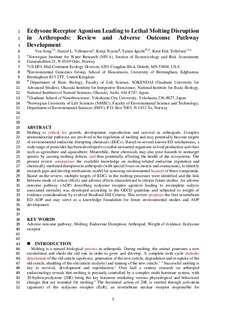| dc.contributor.author | Song, You | |
| dc.contributor.author | Villeneuve, Daniel L. | |
| dc.contributor.author | Toyota, Kenji | |
| dc.contributor.author | Iguchi, Taisen | |
| dc.contributor.author | Tollefsen, Knut Erik | |
| dc.date.accessioned | 2018-04-16T09:47:02Z | |
| dc.date.available | 2018-04-16T09:47:02Z | |
| dc.date.created | 2017-08-26T12:14:16Z | |
| dc.date.issued | 2017 | |
| dc.identifier.citation | Environmental Science and Technology. 2017, 51 (8), 4142-4157. | nb_NO |
| dc.identifier.issn | 0013-936X | |
| dc.identifier.uri | http://hdl.handle.net/11250/2494199 | |
| dc.description | This is an Accepted Manuscript of an article published by American Chemical Society in Environmental Science and Technology, available online: https://pubs.acs.org/ | nb_NO |
| dc.description.abstract | Molting is critical for growth, development, reproduction and survival in arthropods. Complex neuroendocrine pathways are involved in the regulation of molting and may potentially become targets of environmental endocrine disrupting chemicals (EDCs). Based on several known ED mechanisms, a wide range of pesticides has been developed to combat unwanted organisms in food production activities such as agriculture and aquaculture. Meanwhile, these chemicals may also pose hazards to nontarget species by causing molting defects, and thus potentially affecting the health of the ecosystems. The present review summarizes the available knowledge on molting-related endocrine regulation and chemically-mediated disruption in arthropods (with special focus on insects and crustaceans), to identify research gaps and develop mechanistic model for assessing environmental hazards of these compounds. Based on the review, multiple targets of EDCs in the molting processes were identified and the link between mode of action (MoA) and adverse effects characterized to inform future studies. An adverse outcome pathway (AOP) describing ecdysone receptor agonism leading to incomplete ecdysis associated mortality was developed according to the OECD guideline and subjected to weight of evidence considerations by evolved Bradford Hill Criteria. This review proposes the first invertebrate ED AOP and may serve as a knowledge foundation for future environmental studies and AOP development. | nb_NO |
| dc.language.iso | eng | nb_NO |
| dc.publisher | American Chemical Society | nb_NO |
| dc.title | Ecdysone Receptor Agonism Leading to Lethal Molting Disruption in Arthropods: Review and Adverse Outcome Pathway Development | nb_NO |
| dc.type | Journal article | nb_NO |
| dc.type | Peer reviewed | nb_NO |
| dc.description.version | acceptedVersion | nb_NO |
| dc.rights.holder | Copyright © 2017 American Chemical Society | nb_NO |
| dc.source.pagenumber | 4142-4157 | nb_NO |
| dc.source.volume | 51 | nb_NO |
| dc.source.journal | Environmental Science and Technology | nb_NO |
| dc.source.issue | 8 | nb_NO |
| dc.identifier.doi | 10.1021/acs.est.7b00480 | |
| dc.identifier.cristin | 1488785 | |
| dc.relation.project | Norges forskningsråd: 221455 | nb_NO |
| cristin.unitcode | 7464,20,13,0 | |
| cristin.unitname | Økotoksikologi | |
| cristin.ispublished | true | |
| cristin.fulltext | postprint | |
| cristin.qualitycode | 2 | |
